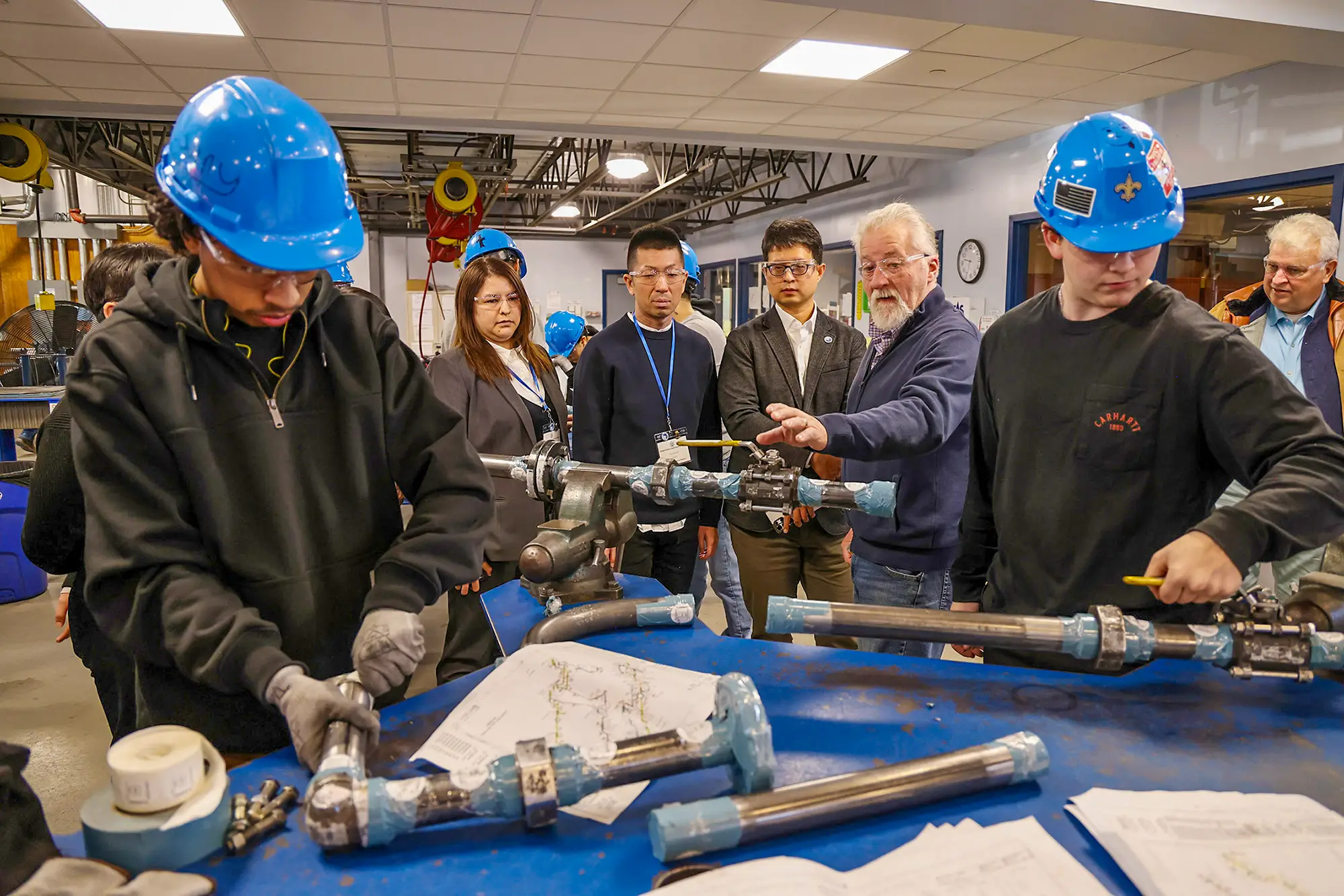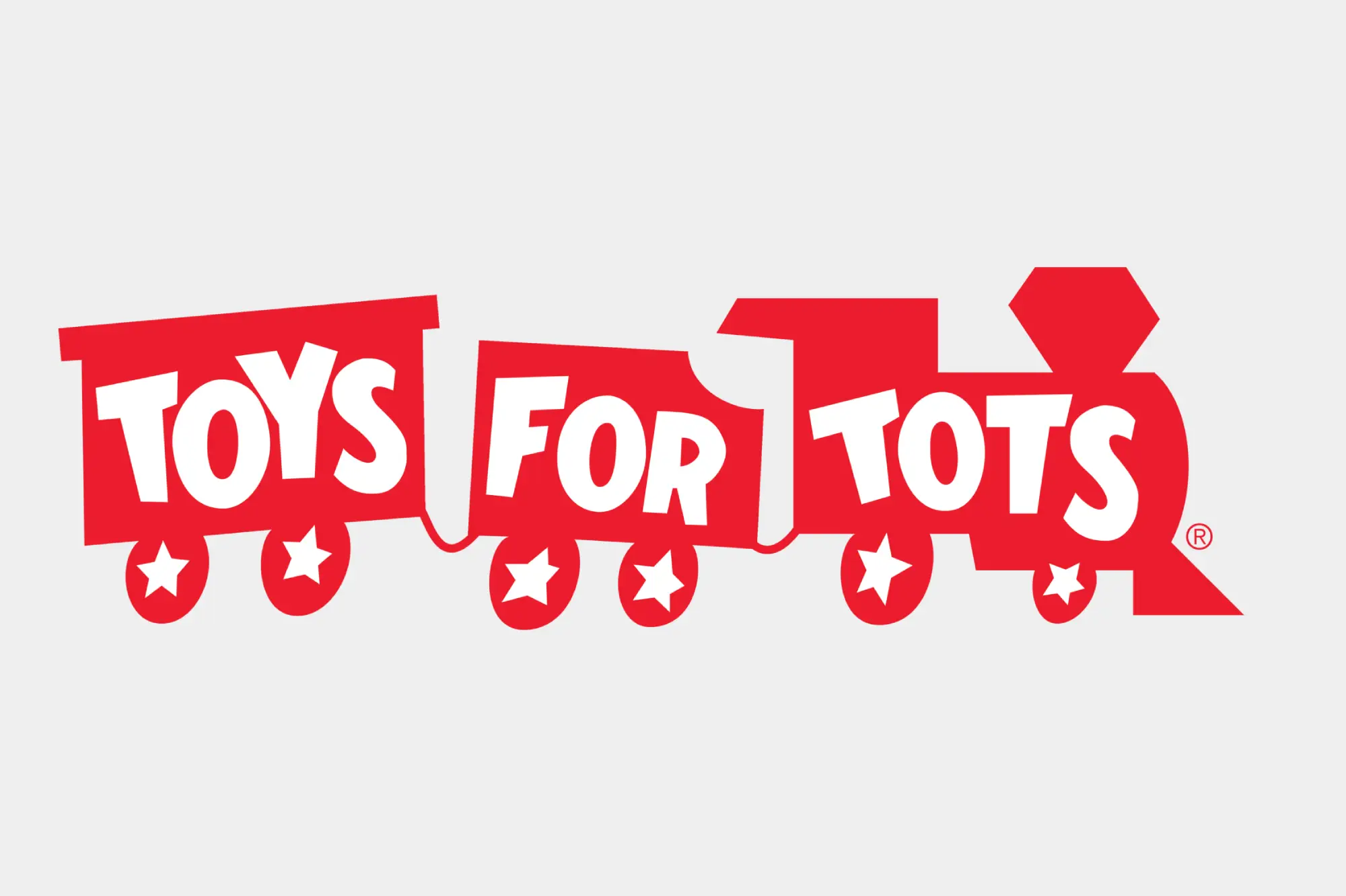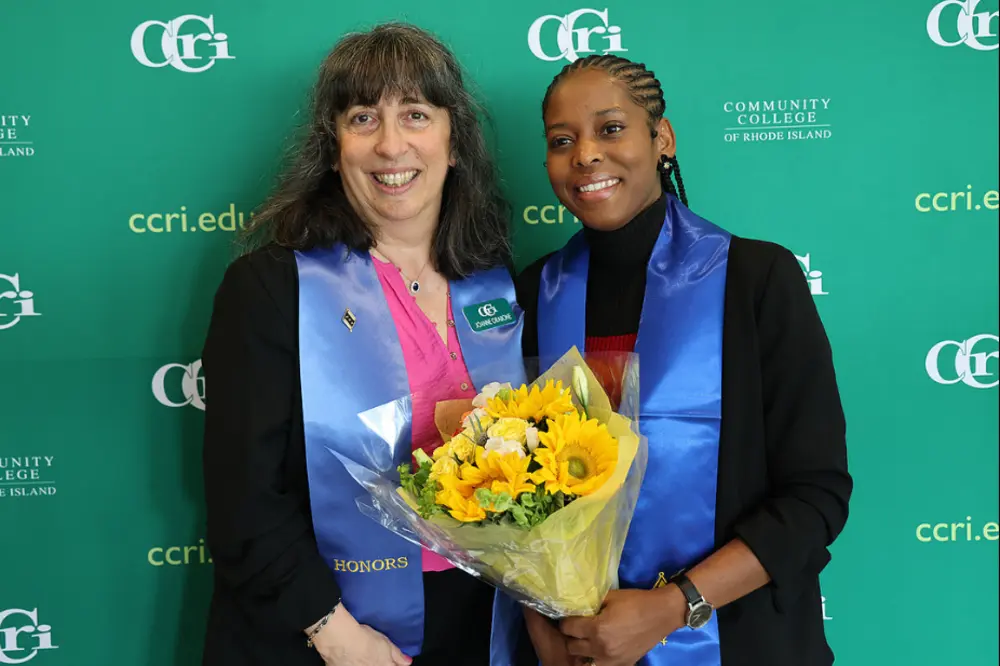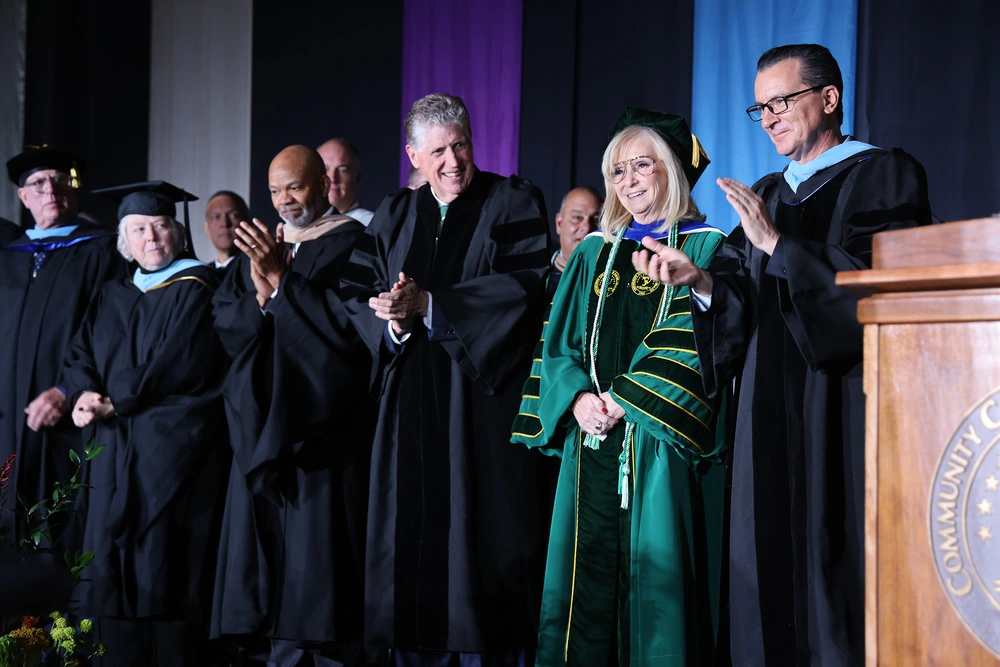Off The Cuff: Becka Carroll

11/17/2023
As CCRI’s Assistant Director of Brand Marketing & Advertising, Staff Assembly Representative, and former Chair of the Diversity, Equity, and Inclusion Committee, Becka Carroll wears many hats. She also helps collect them – along with other donated items – for those in need during the holiday season.
Among her many responsibilities outside of the college, Carroll is a staunch advocate for underrepresented and minoritized members of her community, starting with her work as the Co-Director of the Buy Nothing Day Coat Exchange and continuing with her role as a Women’s Policy Institute (WPI) Fellow.
Through the Buy Nothing Day Coat Exchange, a grassroots 501(c)3 nonprofit that collects winter coats, hats, gloves, and other items, Carroll and her fellow volunteers organize the drive’s annual coat exchange on Black Friday – the day after Thanksgiving – on the State House lawn, offering those who need a winter coat or other gear to pick up one for free, no questions asked. This year’s coat exchange is November 24, and Carroll is also in the process of collecting new, unopened socks for next year’s Spare a Pair Sock and Underwear Drive, an initiative launched four years ago as an extension of the coat exchange.
During the summer, Carroll earned her Master’s in Public Administration from the University of Rhode Island, where she also holds a Bachelor’s Degree in Film Media, Spanish, and French, and began her fellowship with the WPI, allowing her to further develop her passion for policymaking and advocacy. In today’s “Off The Cuff,” we catch up with the brains behind CCRI’s creative marketing and social media campaigns and find out what’s next for the Buy Nothing Day Coat Exchange.
What is your role at the college?
As the Assistant Director of Brand Marketing & Advertising in the Marketing & Communications Department, I’m essentially the project manager for the work that we on the team do. We develop and execute internal and external-facing marketing and advertising campaigns to support recruitment, enrollment, and retention efforts. I also oversee the college’s social media channels (follow us!) and serve as creative and production lead on video projects in partnership with our student-facing video content producer, Ashton Robertson. From distilling information about programs, majors, and college initiatives into digestible, easy-to-read copy for pieces ranging from rack cards to travel pieces, to developing the content and creative for all of the college’s advertising, my teammates probably get sick of seeing my name in their inbox by about 10:00 each morning.
How did you first get involved with the coat drive?
One of my best friends has been leading the Buy Nothing Day Coat Exchange with her mom for the past 10 or so years, so she was my entry point. I first started by knitting scarves and hats to donate toward the drive. When I realized that I could be more helpful by offering my marketing and communications skills, I began taking on a larger role as the years went on. It’s a small, grassroots organization, so I feel very lucky to have been able to play a role in the level of growth we’ve seen in the past few years in terms of our presence, awareness, and communications. I built (and recently redesigned) the first-ever website for the coat drive, created our logo and brand guidelines, and have expanded our social media presence to include Instagram and LinkedIn alongside the original Facebook page.
Most recently, Lauren and I became Co-Directors of the organization. I handle most of the comms, marketing, PR, and the website, while Lauren handles finances, operations, and our partnerships with fellow nonprofits and community partners. During COVID, we became an officially registered 501(c)3 nonprofit, which has been a huge step forward in expanding our capacity for accepting donations of not only coats and winter gear, but of funds to support these efforts as well. Thanks to the support of a great colleague (who moonlights as the best pro bono publicist in the biz), we’ve been able to secure coverage in the local media, which has been hugely helpful in deepening public awareness of our organization, efforts, and how people can get involved.
What new initiatives is the Buy Nothing Day Coat Exchange planning?
Right now, we’re neck-deep (sometimes literally) in coats! Our flagship event takes place the day after Thanksgiving (for most, Black Friday; for us, Buy Nothing Day), so we’re sorting what has been donated so far, coordinating with our collection site leaders, and taking trips to pick up donations from our 18 collection sites across Rhode Island on the days before Thanksgiving.
Earlier this year, our organization was accepted as both a Hanes Sock Drive Partner and a Bombas Giving Partner, so we’re expecting shipments of hundreds – if not thousands – of pairs of socks to be delivered this winter in advance of our fourth annual Spare A Pair sock and underwear drive. We’re fortunate enough to have a few hundred pairs of Bombas socks left over right now, so we’ll be able to offer those to folks who come to the Coat Exchange event on November 24, in addition to winter coats, scarves, gloves, mittens, and warm winter hats.
Spare A Pair kicks off in January and runs through April each year. Socks and underwear are the most commonly-requested items by people living in shelters or experiencing homelessness. For most of us, they’re a basic first layer we put on every morning without much thought, but clean, well-fitting socks and underwear can make a world of difference for someone spending most of the day on their feet and/or without stable access to a shower or laundry. Unlike the big coat distribution event, we distribute donations for Spare A Pair on a rolling basis, so as items are collected, we’re across Rhode Island and coordinating with our community partners to get the items into the hands of folks who need them right away. Last year, we also partnered with Red.Lined Period, another local nonprofit organization which fights period insecurity for youth across Rhode Island, and collected menstrual products as part of our Spare A Pair drive. We’re looking forward to continuing that partnership again in 2024!
What does your fellowship with the Women’s Policy Institute entail?
I was accepted as a 2023-24 Women’s Policy Institute Fellow this summer, and we’re currently in our fourth month of the fellowship. Organized by the Women’s Fund of Rhode Island, the Women’s Policy Institute trains people of all backgrounds and professions from across Rhode Island on the legislative process in Rhode Island, policy, and advocacy, equipping us with the tools and connections we need to advocate for real, lasting change to benefit and protect women and girls in our state. I completed my Master’s in Public Administration in August, so this is all right up my alley and work I’m very passionate about. Last month, our cohort voted to focus on Temporary Caregiver’s Insurance (TCI) – also known as Paid Family Leave or Paid Leave for All – as our chosen policy to support this upcoming legislative session, which begins in January.
We’re working closely with the Economic Progress Institute and other coalition partners to provide support in getting two TCI-related bills passed this session: one which would increase the taxable wage base for employees paying into the program, increase the wage replacement from 60% to 90%, and allow self-employed individuals to opt into the system; the other which would increase the benefit from 6 weeks to 12 weeks, in addition to expanding the definitions to cover care for more family members. As we continue to learn the ins and outs of the legislation and the legislators with whom we’ll be working to get this passed, we’re also being trained on advocacy tactics and strategies and developing our cohort’s capacity for effective, successful lobbying both as individuals and as a team.
What are some examples of policies you’d like to see in place in relation to both the Buy Nothing Day Coat Exchange and the Women’s Policy Institute?
Oh boy, how many do we have room for?
I completed my master’s capstone research working with the Rhode Island Coalition to End Homelessness, as it aligned perfectly with the work I’ve already been doing with the BND Coat Exchange. Having the opportunity to really get into the weeds of homelessness in Rhode Island was hugely eye-opening – and enraging. Released just this past week, the Coalition to End Homelessness’ most recent State of Homelessness in RI report shows a 72% increase in homelessness since 2019, and a staggering 370% increase in unsheltered homelessness, meaning that folks are sleeping rough: on the streets or in places unfit for human habitation, such as a tent or a car.
The solution is very simple: We need more housing. Rents have skyrocketed over the past couple of years and more and more people are being priced out. Especially in terms of truly affordable housing, Rhode Island does not have nearly enough available. In the interim, we desperately need more shelter beds. When there are more than 700 unsheltered people in line for shelter and only seven openings per day, that’s a serious, deadly problem. Everyone deserves a safe, warm place to sleep at night, and with winter approaching quickly, it is imperative that the state step up and address this severe shortage.
However, we also need to be doing much more to prevent homelessness from happening to people in the first place. Flexible Housing Problem-Solving resources need to be funded and developed to make homelessness rare, brief, and non-recurring. We also need to expand the services available to people who need them, such as Permanent Supportive Housing, accessible healthcare, and social work.
Putting my Women’s Policy Institute hat back on, expanding TCI is an imperative this legislative session. Almost 64% of people who utilize Paid Leave are women, who already spend as much as 50% more time providing unpaid care than men. 77% of Rhode Islanders who use TCI do so in order to bond with a new child, and with expenses increasing with the addition of a new family member, receiving only 60% of your usual pay is simply untenable.
The inequity deepens when you look at who contributes to TCI compared to who actually gets to use it: Workers who earn less than $30,000 a year contribute 47% of the total TCI funding stream, yet only constitute 27% of people who actually take the benefit. This means that proportionally, people who are paid the least are paying more into TCI than the highest earners, and they’re using it far less. This is because when you’re already barely making enough to get by, you can’t afford to only make 60% of that. People are going back to work earlier than is recommended and missing out on a benefit they’ve paid into because our current wage replacement system is insufficient.
Rhode Island was one of the first states to implement Paid Family Leave, but now we’re lagging far behind other states in terms of whether the benefit actually benefits people – and who it benefits. We’ve gone from hero to zero, and now’s the time for Little Rhody to make a big comeback.



